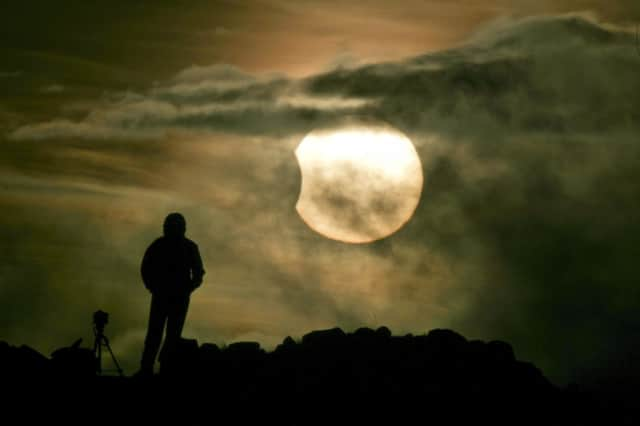Health warning over Fridays’ solar eclipse


The near-total solar eclipse is expected to bring out hundreds of sky-watchers eager to witness the phenomenon as the moon moves in front of the Sun on Friday.
But experts have warned of the real danger of permanent damage to vision if people fail to take the necessary precautions.
Advertisement
Hide AdAdvertisement
Hide AdChildren, who will be starting school during the eclipse, could be especially at risk. Looking directly at the Sun even if most of it is obscured can result in the retina being burned.
Around the UK the proportion of the Sun covered by the Moon will increase towards the north, ranging from 84 per cent in London to 89 per cent in Manchester, 93 per cent in Edinburgh, and 97 per cent in Lerwick in the Shetland Isles.
Times will also vary. In London, the eclipse begins at 8.24am, reaches its maximum extent at 9.31am, and ends at 10.41am. For observers in Edinburgh, the eclipse starts at 8.30am and peaks at 9.35 am.
The last solar eclipse of such significance occurred on August 11 1999, and was “total” - with 100 per cent of the Sun covered - when seen from Cornwall.
Another “deep” partial eclipse visible in the UK will not occur until August 12 2026 and the next total eclipse not until September 2090.
Next Friday’s eclipse will produce a “totality” shadow path that crosses the North Atlantic and covers only two land masses, the Faroe Islands between Scotland and Iceland and the Norwegian archipelago of Svalbard.
Several tour operators have organised trips based around the total eclipse, which will briefly allow the Sun’s outer atmosphere, or corona, to become spectacularly visible.
Dr Susan Blakeney, from the College of Optometrists, said: “You should never look directly at the sun and that applies when there’s a total or partial eclipse as well. This is because the radiation emitted by the Sun is so powerful it may cause a solar burn of the retina.”
Advertisement
Hide AdAdvertisement
Hide AdTogether with the SPA, the Royal Astronomical Society has produced a booklet on how to view the eclipse safely.
Popular methods involve projecting an image from a telescope or binoculars on to a piece of white card, using a mirror to cast the image on to a wall, or making a pin-hole viewer from pieces of card or a cereal box that acts like a lens.
An ordinary colander can also be used to produce multiple eclipse images on a piece of paper.
On Friday morning the Royal Astronomical Society and a group of amateur sky-watchers called the Baker Street Irregular Astronomers will run a joint free event in Regents Park. Members of the public will be invited to view the eclipse using specialist equipment that makes it possible to see sunspots, and solar prominences and filaments.
A similar event is taking place from 8am at the Royal Observatory, Greenwich, assisted by the Flamsteed Astronomy Society.
Total solar eclipses can be seen somewhere on Earth every 18 months on average, but are considered rare events that recur at any given location just once every 360 to 410 years.
A solar eclipse takes place when the Earth, Moon and Sun are aligned and the Moon’s shadow touches the Earth’s surface.
Totality is only visible along a track a few hundred kilometres wide, and away from this path the Sun is partly obscured. Friday’s partial eclipse will be visible across a large part of the northern hemisphere, including the whole of Europe, Greenland, Newfoundland, northern Africa and western Asia.
FOLLOW US
SCOTSMAN TABLET AND MOBILE APPS